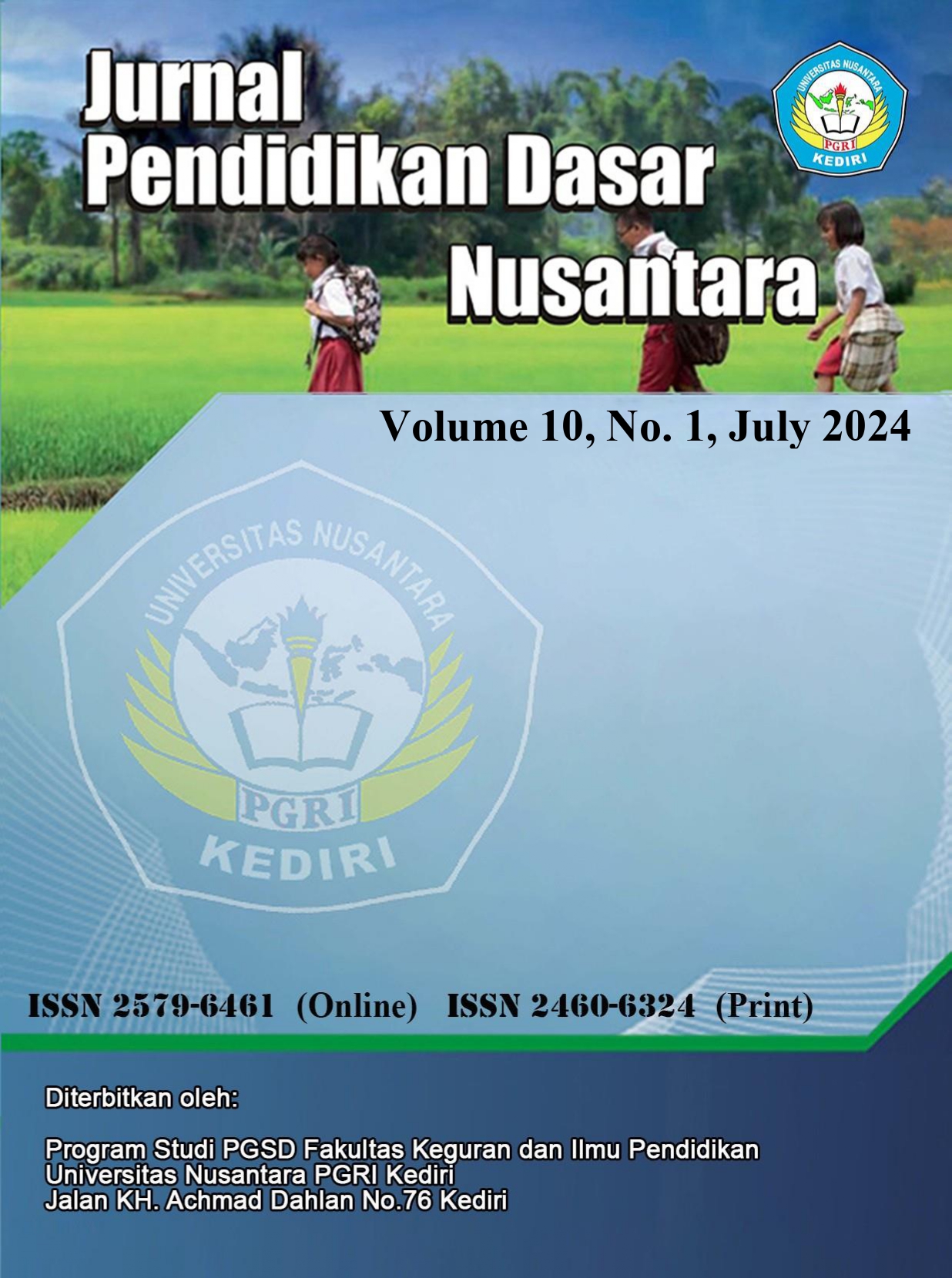Development of Augmented Reality (AR) Based Minibook Media on Solar System Material for Grade VI Elementary School
DOI:
https://doi.org/10.29407/jpdn.v10i1.23211Keywords:
Solar System, Augmented Reality, MinibookAbstract
This research is motivated by the challenges in learning the Solar System at SD Negeri 2 Gedangalas. These learning students' difficulties in understanding science learning about the Solar System in class VI, the lack of use of technology-based learning media, limitations in learning media that can support learning, as well as the lack of application of active and innovative learning in science learning about the Solar System in class VI. Therefore, the aim of this research is to develop Minibook Learning Media Based on Augmented Reality (AR) as an effort to overcom the challenges of learning the Solar System at SD Negeri 2 Gedangalas. This research is included in the Research and Development (R&D) category. Validation is carried out by material experts and media experts. The subjects of this research were students at SD Negeri 2 Gedangalas, with a small-scale trial involving 16 students and a large-scale trial involving 30 students . Data collection used an instrument in the form of a questionnaire. Data analysis was carried out descriptively qualitatively and descriptively quantitatively in the form of percentages. The research results showed that the validation of material experts in all aspects was rated "Very Good" with an average score of 93,35%. Media experts also gave a rating of "Very Good" with an average score of 95,37%. Small group testing showed student ratings of “Very Good” with an average score of 87,75. Thus, it can be concluded that the results of this research have produced an Augmented Reality (AR)-based Minibook learning media product that is effectively used by elementary school students.
Downloads
References
Anggraini, I. D., & Sutama, M. P. (2023). Pengembangan Aplikasi Augmented Reality Berbasis Android Sebagai Media Pembelajaran Pengenalan Sistem Tata Surya Untuk Anak Sekolah Dasar. Universitas Muhammadiyah Surakarta.
Anggrawan, A., C. S., D. S., & Satria, C. (2023). Developing Augmented Reality Learning and Measuring Its Effect on Independent Learning Compared to Traditional Learning. TEM Journal, 975–987. https://doi.org/10.18421/TEM122-44
Astuti, I. A., & Athaya, S. N. (2023). Animasi Motion Graphic Sebagai Media Pembelajaran Sistem Tata Surya Untuk Siswa Kelas 6 Sekolah Dasar. JTIM : Jurnal Teknologi Informasi Dan Multimedia, 4(4), 319–329. https://doi.org/10.35746/jtim.v4i4.211
Brizar, M., & Kažović, D. (2023). Potential Implementation of Augmented Reality Technology in Education. 2023 46th MIPRO ICT and Electronics Convention (MIPRO), 608–612. https://doi.org/10.23919/MIPRO57284.2023.10159865
Dafitri, H., Budiman, A., & Nadhila, F. (2021). Peranan Teknologi Augmented Reality Sebagai Media Pembelajaran di Masa Pandemi Covid-19. Query: Journal of Information Systems, 4(2).
Eryanto, D. R. D., & Prestiliano, J. (2017). Design of learning media for the solar system lesson using animation and virtual reality. Open Science Journal, 2(1). https://doi.org/10.23954/osj.v2i1.790
Iwan, M., & others. (2018). Pengembangan alat peraga materi fluida statis berbasis inkuiri terbimbing untuk meningkatkan keterampilan argumentasi siswa. Universitas lampung.
Kamelia, L. (2015). Perkembangan teknologi augmented reality sebagai media pembelajaran interaktif pada mata kuliah kimia dasar. Jurnal Istek, 9(1).
Kibat, S., Ngelambong, A., & Scott, N. (2023). The Potential of Augmented Reality in Education: A Scoping Review. International Journal of Academic Research in Business and Social Sciences, 13(5). https://doi.org/10.6007/IJARBSS/v13-i5/17072
Matin, A. H., & Utomo, H. W. (2023). Perancangan Aplikasi Augmented Reality Sebagai Media Pembelajaran Tata Surya Pada Sekolah Dasar Kelas 6. JURIKOM (Jurnal Riset Komputer), 10(3), 752–761.
Mubaroq, M. A., & Ilham, M. F. (2023). Peran Teknologi dalam Peningkatan dan Efektivitas Proses Pembelajaran. MASALIQ, 3(4), 541–549. https://doi.org/10.58578/masaliq.v3i4.1209
Nugraha, N. B. (2022). Game Edukasi Interaktif Pengenalan Tata Surya Berbasis Animasi 2D untuk Siswa Kelas 6 SD. Pixel :Jurnal Ilmiah Komputer Grafis, 15(1), 113–120. https://doi.org/10.51903/pixel.v15i1.741
Putra, W. P., & Negara, I. G. A. O. (2021). Pengembangan multimedia sistem tata surya pada muatan ipa. Mimbar Ilmu, 26(1), 108–117.
Sartono, K. E., & Laisaroh, A. (2022). Augmented reality-based textbook innovation as learning media for learning from home. Jurnal Kependidikan Penelitian Inovasi Pembelajaran, 6(1), 93–102. https://doi.org/10.21831/jk.v6i1.39893
Shaikh Mohammed Shaukat. (2023). Exploring the Potential of Augmented Reality (AR) and Virtual Reality (VR) in Education. International Journal of Advanced Research in Science, Communication and Technology, 52–57. https://doi.org/10.48175/IJARSCT-12108
Sri-gran, K., Homjan, S., & Wandee, A. (2024). Research and development teacher education: authentic competency-based assessment. International Journal of Evaluation and Research in Education (IJERE), 13(4), 2489. https://doi.org/10.11591/ijere.v13i4.27911
Supriadi, M., & Hignasari, L. V. (2019). Pengembangan media virtual reality pada muatan pelajaran IPA Kelas VI Sekolah Dasar. JTP-Jurnal Teknologi Pendidikan, 21(3), 241–255.
Torang Siregar. (2023). Stages of Research and Development Model Research and Development (R&D). DIROSAT: Journal of Education, Social Sciences & Humanities, 1(4), 142–158. https://doi.org/10.58355/dirosat.v1i4.48
Tri Wibowo, D., Pramuniati, I., & Ratna Soraya, T. (2023). Learning Media Development of Beginner Written Receptions Based on Augmented Reality Applications. International Journal of Research and Review, 10(1), 528–534. https://doi.org/10.52403/ijrr.20230161
Ula, A. S., & Setyawan, A. (2022). Penggunaan Media Tata Surya Untuk Meningkatkan Hasil Belajar IPA. JURNAL PENA EDUKASI, 9(2), 86. https://doi.org/10.54314/jpe.v9i2.1229
Downloads
Published
Issue
Section
License
Authors who publish with this journal agree to the following terms:
- Copyright on any article is retained by the author(s).
- The author grants the journal, the right of first publication with the work simultaneously licensed under a Creative Commons Attribution License that allows others to share the work with an acknowledgment of the work’s authorship and initial publication in this journal.
- Authors are able to enter into separate, additional contractual arrangements for the non-exclusive distribution of the journal’s published version of the work (e.g., post it to an institutional repository or publish it in a book), with an acknowledgment of its initial publication in this journal.
- Authors are permitted and encouraged to post their work online (e.g., in institutional repositories or on their website) prior to and during the submission process, as it can lead to productive exchanges, as well as earlier and greater citation of published work.
- The article and any associated published material is distributed under the Creative Commons Attribution-ShareAlike 4.0 International License

































